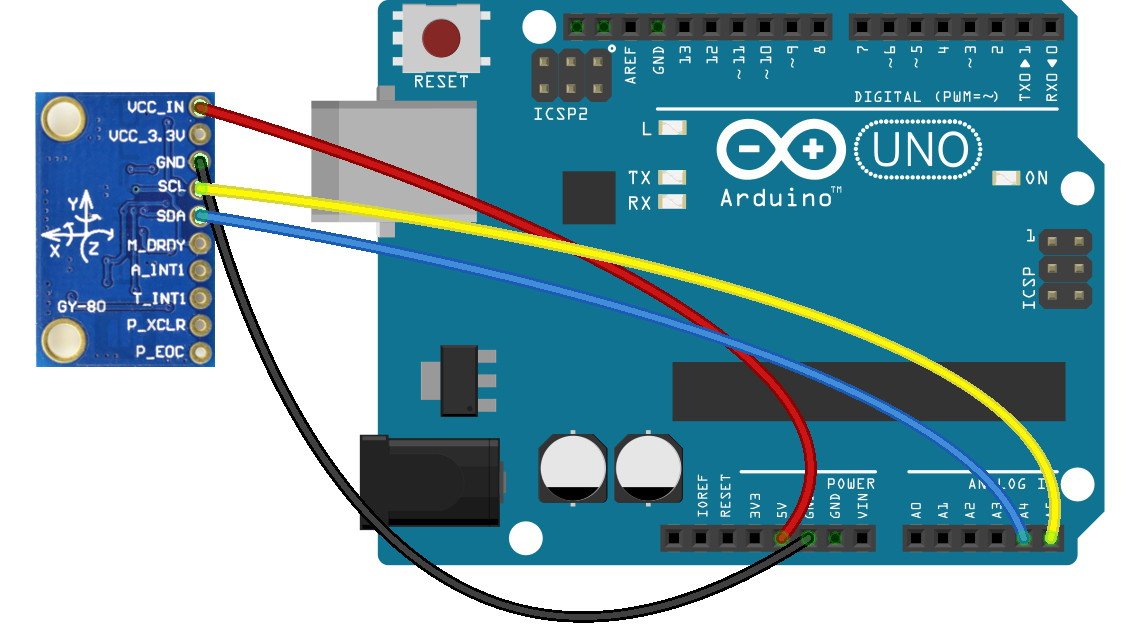3-axis accelerometer ADXL345 and Arduino
The tutorial shows how to measure acceleration using the ADXL345 module for Arduino.
In this example we used the following elements:
- Arduino Uno
-
System module such as the ADXL345 ADXL345 3-axis digital accelerometer I2C / SPI module
- Wire, for example, with hooks
- The ADXL345 library
Connect the sensor with Arduino:
The module communicates using the popular I2C bus. Thus, the connection to the Arduino needs to be done in the following way:
| Module ADXL345 | Pin Arduino |
|---|---|
| VCC | 5 V |
| GND | GND |
| SCL | A5 |
| Traffic | A4 |
Connection diagram module ADXL345 with Arduino Uno.
Program for Arduino
At the beginning of the library you want to add to the environment of the Arduino (Sketch -> Include Library -> Add .ZIP Library...). In the example, we used the following code:
#include#include #include //Assign ID Adafruit_ADXL345_Unified accel = Adafruit_ADXL345_Unified(12345); void displaySensorDetails(void) { sensor_t sensor; accel.getSensor(&sensor); Serial.println("------------------------------------"); Serial.print ("Sensor "); Serial.println(sensor.name); Serial.print ("driver Version: "); Serial.println(sensor.version); Serial.print ("ID: "); Serial.println(sensor.sensor_id); Serial.print ("maximum Value: "); Serial.print(sensor.max_value); Serial.println(" m/s^2"); Serial.print ("minimum Value: "); Serial.print(sensor.min_value); Serial.println(" m/s^2"); Serial.print ("Resolution: "); Serial.print(sensor.resolution); Serial.println(" m/s^2"); Serial.println("------------------------------------"); Serial.println(""); delay(500); } void displayDataRate(void) { Serial.print ("Speed: "); switch(accel.getDataRate()) { case ADXL345_DATARATE_3200_HZ: Serial.print ("3200 "); break; case ADXL345_DATARATE_1600_HZ: Serial.print ("1600 "); break; case ADXL345_DATARATE_800_HZ: Serial.print ("800 "); break; case ADXL345_DATARATE_400_HZ: Serial.print ("400 "); break; case ADXL345_DATARATE_200_HZ: Serial.print ("200 "); break; case ADXL345_DATARATE_100_HZ: Serial.print ("100 "); break; case ADXL345_DATARATE_50_HZ: Serial.print ("50 "); break; case ADXL345_DATARATE_25_HZ: Serial.print ("25 "); break; case ADXL345_DATARATE_12_5_HZ: Serial.print ("12.5 "); break; case ADXL345_DATARATE_6_25HZ: Serial.print ("6.25 "); break; case ADXL345_DATARATE_3_13_HZ: Serial.print ("3.13 "); break; case ADXL345_DATARATE_1_56_HZ: Serial.print ("1.56 "); break; case ADXL345_DATARATE_0_78_HZ: Serial.print ("0.78 "); break; case ADXL345_DATARATE_0_39_HZ: Serial.print ("0.39 "); break; case ADXL345_DATARATE_0_20_HZ: Serial.print ("0.20 "); break; case ADXL345_DATARATE_0_10_HZ: Serial.print ("0.10 "); break; default: Serial.print ("???? "); break; } Serial.println(" Hz"); } void displayRange(void) { Serial.print ("Range: +/- "); switch(accel.getRange()) { case ADXL345_RANGE_16_G: Serial.print ("16 "); break; case ADXL345_RANGE_8_G: Serial.print ("8 "); break; case ADXL345_RANGE_4_G: Serial.print ("4 "); break; case ADXL345_RANGE_2_G: Serial.print ("2 "); break; default: Serial.print ("?? "); break; } Serial.println(" g"); } void setup(void) { Serial.begin(9600); Serial.println("--- Test accelerometer ADXL345 ---"); Serial.println(""); //Initialize the module if(!accel.begin()) { //Connection error Serial.println("failed sensor -- Check connection!"); while(1); } //Select the range accel.setRange(ADXL345_RANGE_16_G); // displaySetRange(ADXL345_RANGE_8_G); // displaySetRange(ADXL345_RANGE_4_G); // displaySetRange(ADXL345_RANGE_2_G); //Wyświetelnie information displaySensorDetails(); //Show additional settings displayDataRate(); displayRange(); Serial.println(""); } void loop(void) { sensors_event_t event; accel.getEvent(&event); //Output in m/sec^2) Serial.print("X: "); Serial.print(event.acceleration.x); Serial.print(" "); Serial.print("Y: "); Serial.print(event.acceleration.y); Serial.print(" "); Serial.print (": "); Serial.print(event.acceleration.C); the Serial.print(" ");Serial.println("m/s^2 "); delay(500); }
The program displays the acceleration along three axes are given in m/sec^2. The results of the program can be seen below:
A screenshot of the serial monitor.































































































































































































































































































































